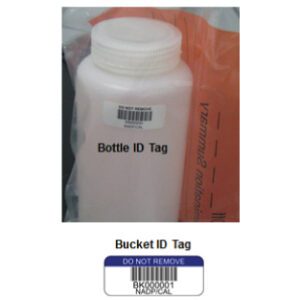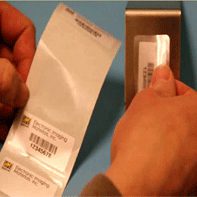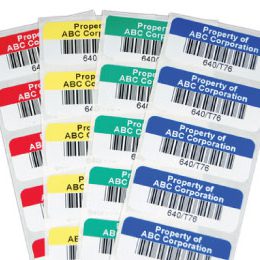If you’ve been dealing with misreads, label peeling, or scanner errors on your Hologic® equipment, it might not be your machine. It could be your labels. Many labs overlook the impact of label compatibility until workflow interruptions or costly reruns demand attention. But you don’t have to wait for problems to pile up.

A proactive lab labeling audit can uncover hidden issues in your current process and help you take corrective action before your equipment throws up red flags. This guide walks you through exactly how to evaluate your labeling workflow to ensure it’s aligned with Hologic performance standards.
Why Conduct a Lab Labeling Audit?
Hologic systems like the ThinPrep® 5000 and Panther Fusion® are designed for high-efficiency, automated diagnostic workflows. But even the most advanced instruments can get derailed by one weak link: your labels. These machines rely on tight tolerances for barcode readability, label placement, and substrate compatibility. A label that peels, smears, misaligns, or fails to scan can halt processing, trigger errors, or require costly reruns.
That’s why conducting a lab labeling audit isn’t just good practice—it’s essential. It gives you a clear view of how well your current label setup supports (or hinders) your diagnostic operations. Auditing your system provides the insight to:
- Identify gaps in label material performance across different environmental conditions
- Evaluate print quality and barcode reliability through real-use simulation
- Verify that the printer hardware and ribbon selection align with the Hologic system specs
- Prevent avoidable jams, misreads, and re-labeling due to layout or adhesion problems
- Stay compliant with traceability standards and reduce labeling waste and inefficiency
With Hologic equipment, precision is everything, and a labeling audit helps you confirm that every label you use meets the mark.
The Labeling Audit Process: Step-by-Step Assessment
Now that you understand why auditing matters, it’s time to take action. The following steps will walk you through the full evaluation process, helping you uncover hidden problems and optimize your labeling system from the ground up. From label materials to environmental performance and team engagement, this checklist is your roadmap to Hologic compatibility.
Step 1: Assess Label Materials
Start by gathering all label types currently in use for your Hologic workflows. This includes everything from vial labels to slides and any label sets for tracking multi-step test components. Don’t forget to review backups or alternate labels used during shortages—if they’re being applied, they need to be part of the audit.
Questions to Ask:
- Are you using paper or synthetic facestocks?
- Do your labels remain intact after refrigeration, alcohol wipes, or handling?
- Are there any signs of fading, curling, or residue?
- Are your labels specifically rated for cryogenic, chemical, or autoclave resistance?
Why It Matters:
Hologic systems require durability. Synthetics like polypropylene or polyester are typically preferred over paper for their resistance to moisture and chemicals. Paper may work fine on paper forms, but it quickly fails in environments with alcohol exposure, temperature shifts, or condensation. If your labels don’t hold up through processing, it’s time to upgrade.
> Tip: Include your adhesive in this review. Many quality control label issues stem from adhesives that can’t bond well to curved vials or cold surfaces. Labels that look fine when first applied may fail after refrigeration or transport unless they’re specifically designed for those conditions.
Step 2: Evaluate Printer and Ribbon Compatibility
Your printer setup can make or break your label performance, especially in high-throughput environments. Even if you’re using the right label material, poor print clarity or ribbon mismatch can lead to misreads, scanner delays, or unreadable barcodes. As part of your lab labeling audit, it is wise to ensure your printing equipment is dialed in to meet Hologic’s precision standards.
Questions to Ask:
- Are you using thermal transfer or laser printing?
- What ribbon type are you using—wax, wax/resin, or resin?
- Is your printer calibrated for the label size and material?
- Are barcodes consistently printing dark, sharp, and aligned?
Why It Matters:
Thermal transfer printing, particularly with resin ribbons, produces labels that can endure chemical exposure, handling, and temperature shifts—all critical in diagnostic workflows. Faded text or blurry barcodes introduce scanning issues that compromise automation and slow down throughput. If your barcodes aren’t scannable the first time, your entire process is vulnerable to error.
> Check: Your DPI settings (300 dpi or higher is usually recommended for barcode printing). Also, confirm the printhead pressure and heat settings are appropriate for your label material and ribbon type. Small misalignments can create big problems. This is your chance to catch and correct them early.
Step 3: Check Barcode Integrity and Layout
Even a perfectly printed, high-quality label loses its value if the barcode doesn’t perform when it matters. Barcode placement and legibility are critical for Hologic systems, which use advanced scanners with specific positioning requirements. Inconsistent printing, placement too close to label edges, or poor contrast can throw off the read and grind automation to a halt.
Questions to Ask:
- Are barcodes printing clearly and consistently?
- Is there enough white space around each code for accurate scanning?
- Are barcodes placed according to Hologic alignment specifications?
- Are they formatted properly (e.g., size, orientation, contrast) for your scanner settings?
Why It Matters:
Misaligned or low-contrast barcodes cause scanning delays, rework, and manual data entry, introducing the exact kind of human error that diagnostics are meant to avoid. Your lab labeling audit should include functional barcode scans under typical lab conditions. That means checking scans under different lighting, at varying angles, and even when containers are slightly curved or frosted. Real-world scanning ensures barcodes hold up beyond the desk and during actual usage, not just in theory.
Not sure if your current labels are holding up? Let us help. Electronic Imaging Materials (EIM) provides consultations and sample kits. We’ll review your lab labeling audit results and recommend proven solutions that align with Hologic specs and your lab’s workflow.
Step 4: Assess Label Application Process
It’s not just about the label—it’s about how it’s applied. Even the highest-quality labels can fail if applied incorrectly. Wrinkles, bubbles, and weak contact with the container can all lead to peeling edges or unreadable barcodes, especially when exposed to cold storage or cleaning agents. Consistent label application is a critical but often overlooked step in maintaining Hologic compatibility.
Questions to Ask:
- Are staff trained on best application practices?
- Are labels pressed firmly onto clean, dry surfaces with even pressure?
- Is there any bubbling, wrinkling, or misplacement during application?
- Are gloves or environmental factors (like condensation or frost) interfering with adhesion?
Why It Matters:
Application inconsistencies often lead to peeling or scanner errors. If one technician applies labels differently from another, it introduces variability that Hologic systems won’t tolerate. Scanners expect consistency; labels that shift or misalign can break that pattern.
> Fix: Consider using label applicators for consistent pressure and placement, especially in high-volume labs. Also, create visual guides or SOPs to train and retrain staff on best practices for labeling different container types. Consistency at this step leads to fewer relabels, fewer errors, and more uptime across shifts.

Step 5: Test for Environmental Durability
Labels don’t just live on the lab bench. They travel with your samples—from cold storage to autoclaves to the hands of gloved technicians—and every transition poses a new challenge. If your labels fail at any point in that journey, so does your ability to track, identify, or validate a sample.
Environmental durability is a non-negotiable in diagnostics. Whether you’re handling cervical samples with preservatives or frozen specimens that will be thawed and refrozen, labels must hold strong and stay readable.
Questions to Ask:
- Do your labels maintain adhesion through freeze-thaw cycles?
- Can they withstand disinfectant wipes or solvent exposure?
- Are print and barcode quality preserved in cold, moist, or warm conditions?
- Do labels show signs of edge lift, bubbling, or fading after environmental stress?
Why It Matters:
Diagnostic labels must perform under pressure, both literal and environmental. If yours aren’t designed for rugged handling or varying temperatures, they can cause downstream delays, scan errors, or even compromise patient data. Your lab labeling audit should simulate real-world conditions: take labeled vials through your full sample path and check for deterioration at each stage. Labels that flake, fade, or fall off don’t just risk your process but your credibility.
Step 6: Verify Hologic Compatibility
Compatibility is a requirement for Hologic equipment. These systems have very specific needs regarding label format, substrate type, barcode alignment, and overall durability. A label that’s even slightly out of spec can throw off automation, delay processing, or trigger rework. This step is your final quality check to ensure you’re not unknowingly sabotaging your own performance.
Questions to Ask:
- Have you reviewed the technical label specifications provided directly by Hologic?
- Do your current labels consistently align with your device’s barcode scanning field and gripping points?
- Are there any recurring issues like jams, barcode rejections, or scanner misfires?
- Have you tested your label performance through multiple Hologic workflows and environmental stressors?
Why It Matters:
Even labels that perform well on other lab equipment may fail in a Hologic environment if they weren’t engineered with those systems in mind. For example, a label that’s too thick or too wide can interfere with the ThinPrep® 5000’s vial grippers. Meanwhile, the Panther Fusion® places high demands on label durability, especially under refrigeration, thawing, and chemical exposure.
> Use Case: On the ThinPrep® 5000, label placement that’s even a few millimeters off can interfere with automated gripping. On the Panther Fusion®, labels that don’t survive moisture exposure can cause scan errors midway through a testing cycle. Verifying Hologic compatibility ensures that your labels are an asset to your workflow, not an obstacle.
Optimize Your Labeling Strategy With EIM
Electronic Imaging Materials helps you build a complete, stress-free labeling workflow that supports compliance, speed, and diagnostic integrity. As a Hologic Preferred Supplier, our team is more than qualified to work closely with labs using Hologic systems to solve barcode misreads, adhesive failures, and misalignment issues before they start.
Let’s take the guesswork out of labeling. Contact EIM today for a consultation, sample kit, or a full system review—and get labels that work smarter, scan faster, and stay put through every step of your diagnostic process.





